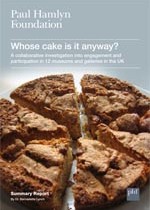Project overview
Following decades of investment in participation in UK museums and galleries, this study’s main objective was to work with staff and community partners of 12 UK museums and galleries, all of which shared a commitment to, and reputation for, community participation. The study took a critical look at how these organisations understand their community engagement and how embedded community engagement had become within the organisation; like Brighton Rock, it asked, is engagement really through and through?
Museums continue to operate within a competitive funding culture which breeds a lack of openness. There was a significant level of trust and confidentiality negotiated in order to create a space for the degree of open discussion necessary for this study to operate. In such a competitive climate, it took courage for these organisations to be willing to share these issues with community partners and with each other, an agreement made in return for a high level of confidentiality1. Information would not be used to create a table of rated organisations, nor to present organisations solely as ‘case studies’. Instead, the process focused on three main areas:
- The experience of community partners
- The experience of museum and gallery staff
- Examples of change in action: transformative and transferable practice
Participatory techniques
Many of the workshops’ group activities revolved around Augusto Boal’s concepts of participatory drama. Staff members and community partners developed and acted out scenes which communicated how they perceived elements of their engagement practice. The process is based on “understanding, knowing by experience and experimenting”, seeking to expand participants’ “capacity to recognise, to apprehend and to learn”. As well as this enactment, workshops utilised a wider range of participatory practices, including:
- Committing to an open discussion between staff and community
members, about varying degrees of engagement practice - Imagining how it feels to be in someone else’s position, a process which
uncovered unspoken relations and differing assumptions - An organisational questionnaire developed and completed by participants
- Discourse analysis – a review of policy and organisational documents
- Contribution to a ‘storywall’ following all exercises, with entries added to an
online blog - One-to-one interviews to gauge anonymous views of participants
- A ‘Dragon’s Den’ process, in which organisations presented their ways of
working to staff and community partners from other organisations, who
acted as ‘critical friends’, challenging and interrogating
Each organisation worked with a group of at least ten participants comprising equal numbers of staff and community partners. Representing a wide range of experience, the community members (some relieved to be asked) enthusiastically contributed to understanding and delivered a useful critique based on their experience.
Need to talk it through
For museums and galleries embarking on new participatory work, there was often a feeling that much-needed communication was neglected. One staff member said that, at senior management level, there was a lack of willingness to address issues. “The nature of the work we are undertaking is unknown and new – we have to review it continuously,” they said. “The linkages and connections we are making are often for the first time – it’s natural to need to talk it through.”
Short-termism and funding
The UK public sector is increasingly committed to getting public input on public services, for example in health, education, housing and social services. Yet such practices as engagement boards, or project board representation, are still unusual within UK museums and galleries, and they are in danger of being left behind.
During the study it became clear that, in terms of public engagement practice, the system of short-term project funding that supports museums and galleries actively discourages reflection, serving to perpetuate an illusion that the work is more effective than it is. The imperative to attract further funding contributes to a fear of reflection and a perceived ‘insecurity’ of organisations and their senior management in opening up discussion of the work.
A staff member of one of the larger museums offered this view: “There’s a feeling of it all being quite fragile when we present ourselves publicly. But we can’t have these discussions internally, because it’s seen as ‘negative’.” This study’s methodology attempts to cut through the overriding pressure to represent work in a purely positive light, focusing instead on long-term fundamental assumptions and the reality of participants’ experience.
Footnotes
- 1 Other than noting positive transformative or transferable practice shared between many of the organisations in the study, none of the organisations are specifically identified here in terms of a critical analysis of their engagement work. This is to encourage the continuation of mutually supportive processes of change and avoid a hierarchy of practice, which was not the intention of the study. However, all the organisations involved saw the full, unabridged report and had the chance to obtain feedback on their organisation’s engagement practice in special group meetings, organisational ‘surgeries’ and planning sessions, subsequently organised by Paul Hamlyn Foundation
